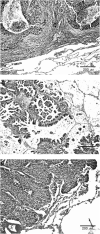Prognostic value of nonangiogenic and angiogenic growth patterns in non-small-cell lung cancer
- PMID: 15328525
- PMCID: PMC2409915
- DOI: 10.1038/sj.bjc.6602134
Prognostic value of nonangiogenic and angiogenic growth patterns in non-small-cell lung cancer
Abstract
An essential prerequisite of nonangiogenic growth appears to be the ability of the tumour to preserve the parenchymal structures of the host tissue. This morphological feature is visible on a routine tissue section. Based on this feature, we classified haematoxylin and eosin-stained tissue sections from 279 patients with non-small-cell lung cancer into three growth patterns: destructive (angiogenic; n=196), papillary (intermediate; n=38) and alveolar (nonangiogenic; n=45). A Cox multiple regression model was used to test the prognostic value of growth patterns together with other relevant clinicopathological factors. For overall survival, growth pattern (P=0.007), N-status (P=0.001), age (P=0.020) and type of operation (P=0.056) were independent prognostic factors. For disease-free survival, only growth pattern (P=0.007) and N-status (P<0.001) had an independent prognostic value. Alveolar (hazard ratio=1.825, 95% confidence interval=1.117-2.980, P=0.016) and papillary (hazard ratio=1.977, 95% confidence interval=1.169-3.345, P=0.011) growth patterns were independent predictors of poor prognosis. The proposed classification has an independent prognostic value for overall survival as well as for disease-free survival, providing a possible explanation for survival differences of patients in the same disease stage.
Figures



References
-
- Cannistra SA (2000) When is a ‘Prognostic factor’ really prognostic? J Clin Oncol 18: 3745–3747 - PubMed
-
- Cox G, Jones JL, Steward WP, O'Byrne KJ (2000) Angiogenesis and non-small-cell Lung cancer. Lung Cancer 27: 81–100 - PubMed
-
- Duarte IG, Bufkin BL, Pennington MF, Gal AA, Cohen C, Kosinski, Mansour KA, Miller JI (1998) Angiogenesis as a predictor of survival after resection for stage I non-small-cell lung cancer. J Thorac Cardiovasc Surg 115: 652–658 - PubMed
-
- Folkman J (1990) What is the evidence that the tumours are angiogenesis dependent? J Natl Cancer Inst 82: 4–6 - PubMed
MeSH terms
LinkOut - more resources
Full Text Sources
Medical

